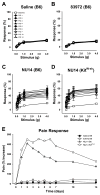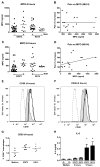Host-pathogen interactions mediating pain of urinary tract infection
- PMID: 20225955
- PMCID: PMC2841043
- DOI: 10.1086/651275
Host-pathogen interactions mediating pain of urinary tract infection
Abstract
Background: Pelvic pain is a major component of the morbidity associated with urinary tract infection (UTI), yet the molecular mechanisms underlying UTI-induced pain remain unknown. UTI pain mechanisms probably contrast with the clinical condition of asymptomatic bacteriuria (ASB), characterized by significant bacterial loads without lack symptoms.
Methods: A murine UTI model was used to compare pelvic pain behavior elicited by infection with uropathogenic Escherichia coli strain NU14 and ASB strain 83972.
Results: NU14-infected mice exhibited pelvic pain, whereas mice infected with 83972 did not exhibit pain, similar to patients infected with 83972. NU14-induced pain was not dependent on mast cells, not correlated with bacterial colonization or urinary neutrophils. UTI pain was not influenced by expression of type 1 pili, the bacterial adhesive appendages that induce urothelial apoptosis. However, purified NU14 lipopolysaccharide (LPS) induced Toll-like receptor 4 (TLR4)-dependent pain, whereas 83972 LPS induced no pain. Indeed, 83972 LPS attenuated the pain of NU14 infection, suggesting therapeutic potential.
Conclusions: These data suggest a novel mechanism of infection-associated pain that is dependent on TLR4 yet independent of inflammation. Clinically, these findings also provide the rational for probiotic therapies that would minimize the symptoms of infection without reliance on empirical therapies that contribute to antimicrobial resistance.
Conflict of interest statement
Authors have not conflict of interest.
Figures






Comment in
-
Uro-science.J Urol. 2010 Nov;184(5):2205-6. doi: 10.1016/j.juro.2010.07.013. Epub 2010 Sep 18. J Urol. 2010. PMID: 22520012 No abstract available.
Similar articles
-
Mechanisms of pain from urinary tract infection.Int J Urol. 2014 Apr;21 Suppl 1(0 1):26-32. doi: 10.1111/iju.12309. Int J Urol. 2014. PMID: 24807489 Free PMC article. Review.
-
TRPV1 and the MCP-1/CCR2 Axis Modulate Post-UTI Chronic Pain.Sci Rep. 2018 May 8;8(1):7188. doi: 10.1038/s41598-018-24056-0. Sci Rep. 2018. PMID: 29739958 Free PMC article.
-
Bladder infection with uropathogenic Escherichia coli increases the excitability of afferent neurons.Am J Physiol Renal Physiol. 2022 Jan 1;322(1):F1-F13. doi: 10.1152/ajprenal.00167.2021. Epub 2021 Nov 15. Am J Physiol Renal Physiol. 2022. PMID: 34779263 Free PMC article.
-
Lipopolysaccharide Domains Modulate Urovirulence.Infect Immun. 2016 Oct 17;84(11):3131-3140. doi: 10.1128/IAI.00315-16. Print 2016 Nov. Infect Immun. 2016. PMID: 27528276 Free PMC article.
-
Host Responses to Urinary Tract Infections and Emerging Therapeutics: Sensation and Pain within the Urinary Tract.Microbiol Spectr. 2016 Oct;4(5). doi: 10.1128/microbiolspec.UTI-0023-2016. Microbiol Spectr. 2016. PMID: 28087925 Review.
Cited by
-
Protamine sulfate induced bladder injury protects from distention induced bladder pain.J Urol. 2013 Jan;189(1):343-51. doi: 10.1016/j.juro.2012.08.189. Epub 2012 Nov 20. J Urol. 2013. PMID: 23174261 Free PMC article.
-
Mechanisms of pain from urinary tract infection.Int J Urol. 2014 Apr;21 Suppl 1(0 1):26-32. doi: 10.1111/iju.12309. Int J Urol. 2014. PMID: 24807489 Free PMC article. Review.
-
Antinatriuretic phenomena seen in children with acute pyelonephritis may be related to the activation of intrarenal RAAS.Medicine (Baltimore). 2018 Sep;97(36):e12152. doi: 10.1097/MD.0000000000012152. Medicine (Baltimore). 2018. PMID: 30200111 Free PMC article.
-
Sub-noxious Intravesical Lipopolysaccharide Triggers Bladder Inflammation and Symptom Onset in A Transgenic Autoimmune Cystitis Model: A MAPP Network Animal Study.Sci Rep. 2018 Apr 26;8(1):6573. doi: 10.1038/s41598-018-24833-x. Sci Rep. 2018. PMID: 29700406 Free PMC article.
-
Atypical sensors for direct and rapid neuronal detection of bacterial pathogens.Mol Brain. 2016 Mar 9;9:26. doi: 10.1186/s13041-016-0202-x. Mol Brain. 2016. PMID: 26960533 Free PMC article. Review.
References
-
- Schappert SM. Ambulatory care visits of physician offices, hospital outpatient departments, and emergency departments: United States, 1995. Vital Health Stat. 1997;13:1–38. - PubMed
-
- Schaeffer AJaS EM. Campbell-Walsh Urolog. 9. Elsevier; 2007. Infection and Inflammation.
-
- Nicolle LE, Bradley S, Colgan R, Rice JC, Schaeffer A, Hooton TM. Infectious Diseases Society of America guidelines for the diagnosis and treatment of asymptomatic bacteriuria in adults. Clin Infect Dis. 2005;40:643–54. - PubMed
-
- Hang L, Frendeus B, Godaly G, Svanborg C. Interleukin-8 receptor knockout mice have subepithelial neutrophil entrapment and renal scarring following acute pyelonephritis. J Infect Dis. 2000;182:1738–48. - PubMed
Publication types
MeSH terms
Substances
Grants and funding
LinkOut - more resources
Full Text Sources
Other Literature Sources
Medical

